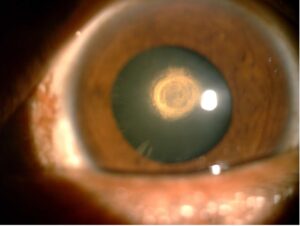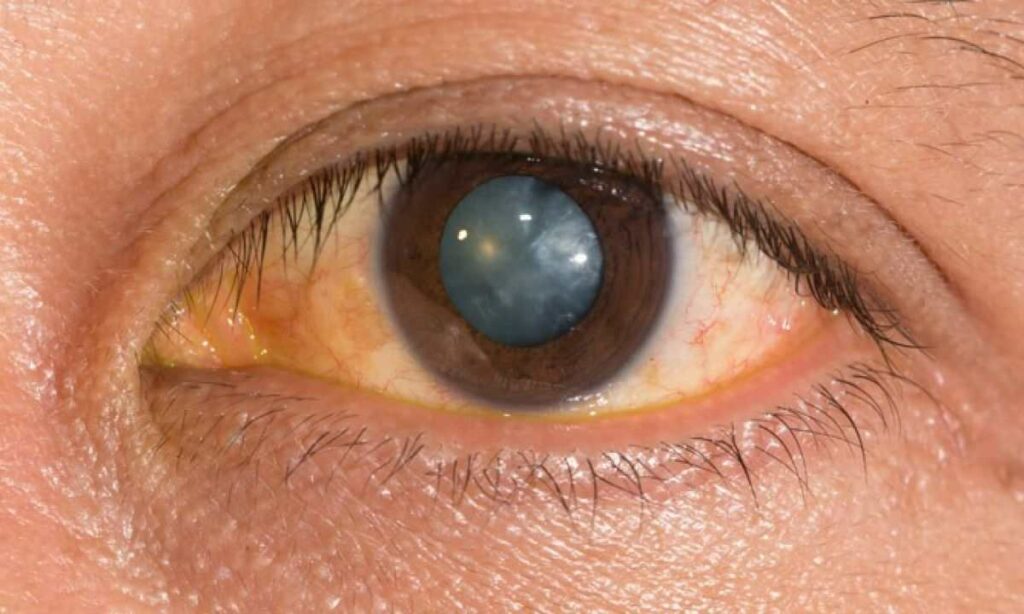If you have been told by your doctor that you have a posterior subcapsular cataract, then it is important for you to learn more about what this means. This type of cataract can cause vision problems, so it is important to understand the symptoms and treatment options. In this blog post, we will discuss everything you need to know about posterior subcapsular cataracts. We will cover what causes them, how they are diagnosed, and the treatment options available.
Contents
What Is Posterior Subcapsular Cataract?
 A posterior subcapsular cataract (PSC) is a lens opacity situated posteriorly in the eye’s capsule. It is a condition that starts in the back of the eye’s lens and develops slowly, eventually leading to a decrease in vision. PSC is more common in individuals over 40 years of age and often results from long-term exposure to UV rays, diabetes, steroid use, or other medical conditions.
A posterior subcapsular cataract (PSC) is a lens opacity situated posteriorly in the eye’s capsule. It is a condition that starts in the back of the eye’s lens and develops slowly, eventually leading to a decrease in vision. PSC is more common in individuals over 40 years of age and often results from long-term exposure to UV rays, diabetes, steroid use, or other medical conditions.
Many people believe that this type of cataract is dangerous, but the truth is that it’s not. PSC can be treated with eye drops or medications, laser treatments, and even surgery.
It is estimated that about 10% of people with cataracts have PSC. Early diagnosis is important, as treatment can slow the progression of the condition and help preserve vision. Do not delay in seeking medical attention if you experience any symptoms of PSC.
What Are the Symptoms To Look For?
The most common symptom associated with PSC is blurred vision, but other signs and symptoms may include:
- Double vision: It is one of the most common symptoms of PSC and can interfere with your ability to focus on objects.
- Light sensitivity: Light can seem overly bright, even painful for individuals with PSC.
- Halos around lights: A halo is a circular or arc-shaped colored area that may appear around bright lights. It is caused when light rays scatter in the eye.
- Reduced color intensity: Colors may appear faded or less intense than before.
These are simply common and potential symptoms associated with PSC. It’s important to note that everyone is different and may experience different signs or intensities of the condition. If you suspect you have any of these symptoms, it’s best to seek the advice of an eye care professional for an accurate diagnosis and appropriate treatment plan.
Otherwise, this can lead to more serious vision problems and even blindness. It’s important to note that PSC is not curable, but it can be managed with proper medical treatment and lifestyle changes.
What Are Some Causes And Risk Factors?
 There are a few causes and risk factors associated with posterior subcapsular cataracts. These include:
There are a few causes and risk factors associated with posterior subcapsular cataracts. These include:
- Age: It is one of the most common age-related eye diseases, affecting nearly half of all people over the age of 65.
- Exposure to UV light: Long-term exposure to ultraviolet light can cause damage to the lens and increase the risk of developing a PSC.
- Medical conditions: Some medical conditions such as diabetes or autoimmune disorders can increase your chances of developing a PSC.
- Medication: Certain medications, such as steroids or diuretics, can increase the risk of developing a PSC.
- Genetics: Occasionally, posterior subcapsular cataracts are caused by inherited genetic conditions.
- Previous eye surgery: Previous eye surgeries can also cause damage to the lens and increase the chances of developing a PSC.
Overall, these are the most common causes and risk factors associated with posterior subcapsular cataracts. It’s important to speak to your ophthalmologist if you experience any of the symptoms related to this condition. As early diagnosis and treatment are key for preserving your vision.
In addition, there could be some other risk factors that increase the risk of PSC, such as:
- Smoking
- Having a family history of eye diseases
Be aware of these risk factors and make sure to inform your doctor if any of these apply to you. With that knowledge, your ophthalmologist will be better equipped to make a diagnosis and treatment plan that’s tailored to you.
How Is It Diagnosed?
The diagnosis is usually done through a comprehensive eye examination, which includes tests for visual acuity and refraction. Your doctor may also use slit-lamp biomicroscopy to examine your eyes more closely. With this test, your doctor will look at the back of the lens and other structures in order to check for signs of posterior subcapsular cataracts.
Additionally, your doctor may use imaging tests, such as ultrasound or optical coherence tomography (OCT), to get a more detailed look at the condition. After diagnosis and confirmation of posterior subcapsular cataract, treatment can begin.
How Fast Do Subcapsular Cataracts Develop?
While subcapsular cataracts can develop at any age, they generally tend to occur more frequently in people over the age of 40. In some cases, they may develop rapidly and require prompt diagnosis and treatment. The theory behind how fast they develop is still up for debate. But some research suggests that it could be caused by long-term exposure to UV rays, as well as certain medications or even trauma.
More often, the posterior subcapsular cataracts are a slow-growing condition. It is believed to develop over time due to various risk factors. Therefore, if you are at higher risk of developing a subcapsular cataract. Regular eye examinations and preventive measures can help to reduce the chance of its onset.
How Can You Treat Posterior Subcapsular Cataracts?
If you are diagnosed with posterior subcapsular cataracts, the recommended treatment is a surgical procedure known as phacoemulsification. During this procedure, your ophthalmologist will use an ultrasonic instrument to break up and remove the lens from inside the eye. This allows for a new artificial intraocular lens (IOL) to be inserted into the eye.
The goal of the procedure is to improve vision and may be used in combination with other treatments such as laser surgery or vitrectomy.
Depending on the severity of your cataracts, you may also need additional treatments to address any other underlying causes that might be contributing to their development. In some cases, medications such as corticosteroids or anti-inflammatory drugs may be prescribed to help reduce inflammation or slow the progression of cataract formation.
Your ophthalmologist will discuss with you the best course of treatment for your individual case. So it is important that you follow their instructions and ask any questions you may have about the process.
Finally, it is essential to follow up with your doctor regularly after the surgery. In order to ensure that your eyes are healing properly and that all necessary measures have been taken to prevent any complications from arising.
It is important to take all steps necessary to protect your vision from further damage. So if you think you may have posterior subcapsular cataracts, please consult with a professional ophthalmologist right away. With the right treatment, you can enjoy improved vision and reduce your risk of further complications.
Can It be Prevented?
 While posterior subcapsular cataracts cannot be prevented, there are some things that you can do to reduce your risk and slow the progression of the condition. Some of the tips include:
While posterior subcapsular cataracts cannot be prevented, there are some things that you can do to reduce your risk and slow the progression of the condition. Some of the tips include:
- Wearing protective eyewear such as sunglasses when outdoors
- Avoiding smoking and second-hand smoke
- Have regular eye exams
- Eating a balanced diet ensures that your eyes are receiving the nutrients they need
- Limiting exposure to UV light by using hats and umbrellas when in direct sunlight.
- Using eye lubricants if you suffer from dry eyes
These are some things that you can do to help reduce your risk and slow the progression of posterior subcapsular cataracts. It is important to remember that if you think something may be wrong with your eyes. It is best to speak with an ophthalmologist in order to get a proper diagnosis and treatment plan.
Early detection can make a big difference when it comes to any eye condition. So it is important to be aware of any changes in your vision and to seek medical attention should you notice any.
Conclusion
In a nutshell, posterior subcapsular cataracts can be a serious issue when it comes to vision health. If your doctor diagnoses you with this condition, they can work with you to figure out the best course of treatment. Which may involve surgery and/or a special type of lens implantation.
It’s important to be evaluated for any changes in your vision regularly so that early detection can help preserve your sight. With the right care, you can help to alleviate the symptoms and reduce the effects of a posterior subcapsular cataract. If you have any further questions or concerns about this condition. Make sure to speak with your eye doctor for more information.
For more information and guidance, be sure to contact Mantra Care. At MantraCare we have a team of experienced eye surgeons, who will be happy to answer any questions on cataract surgery. Call us at +91-9711116605 for any inquiries.
